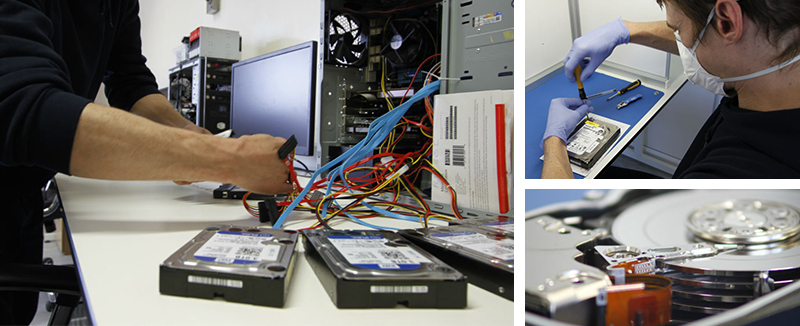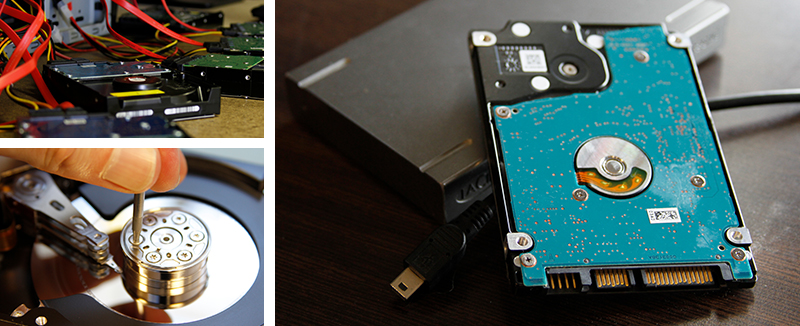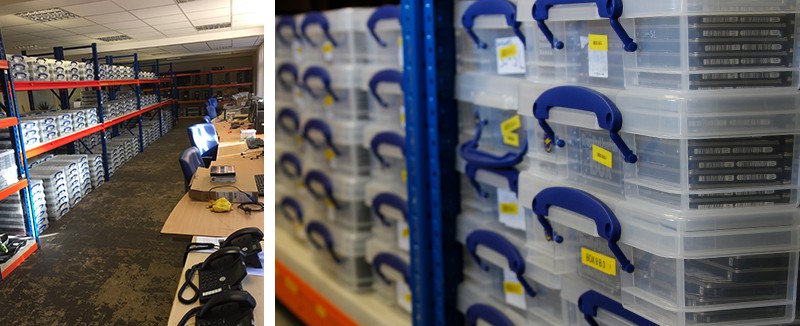The hard disk data recovery services provided by R3 Data Recovery are second to none. We understand how important your data is to you and leave no stone unturned in recovering your data.
Using the very latest technology and recovery techniques we rescue data from every conceivable problem!
- Operating Systems - Windows, Apple MAC, Linux, Unix
- Computer Types - Desktop, Server, Laptop, Apple MAC
- Drive Types - Serial ATA (SATA), (IDE, EIDE), SCSI, and SAS
Data loss can happen at any time and can happen in the most unexpected ways. We can recover your data from the most unlikely disasters.
At R3 Data Recovery we think we've seen every possible way of losing data. Flood damaged drives with severe platter damage due to the disaster, phones dropped in toilets during a good night out and pen drives that have been run over by cars. We've even been asked to recover data from a hard drive that was physically lost, we're good but not that good!

There are three common issues that cause hard drives to fail and subsequently need the data recovering.
- Degraded Hard Drives - Deleted Files, Deleted Partitions, Formatted Drives, Lost BIOS
- Mechanically Failed Hard Drives - Clicking or Ticking Noises, Power Failures, Head Crashes
- Electronically Failed Hard Drives - Power Surges, Incorrect Power Supplies
- Heart Stopping - Dropped / Knocked Drives, Fire Damaged, Water / Flood Damage
Hard drive failures require immediate action. You need fast, secure results, and R3 offers the solutions you need to effectively maintain your data and system after any type of failure. Call us today at{' '} 0800 999 3282 {' '} to get started with your unique case.
Degraded Hard Drives
There are millions of storage sectors on a hard drive. These sectors contain the data stored on the hard drive. Unfortunately these sectors do fail, and when they do the data stored in that sector can't be read by a computer any more. The computer will try and communicate with the failed sector but will give up after time. An example of this is when a computer is operating at a slower speed. Also, a computer can fail to boot up, this again maybe down to a degraded drive and files needed to boot the computer may well be stored in a bad sector. The computer with try to re-allocate the contents of the bad sector but there are only so many sectors available for re-allocation and once you have ran out of available sectors this is where you will start seeing problems rise.
To recover the data, we attach the failed hard drive to a specialised computer where we take control of the read speeds and how the hard drive spins. This allows us more time to integrate the failed storage sectors and provides a back door method of reading the data. Once we have completed this process we have an identical image of the degraded drive, where we can recover the data from.
This is also a common problem with USB Pen Drives, Flash Media Drives such as CF Cards, SD Cards, Micro SD Cards and SSD's. Although the recovery process is completely different to that of a hard drive, we can still recover the data successfully.
Electronically Failed Hard Drives
There's nothing more frustrating than powering on a computer or connecting a hard drive to a computer and nothing happens. No noises, no flashing lights, no life at all! As far as it appears the hard drive is completely dead!
This all points to an issue with the electronics of the hard drive, although there are times when an electronic fault is fixed only to unearth additional problems. The electronics are controlled by the PCB connected to the hard drive. The PCB is the heart beat of a hard drive, if the PCB has failed then the hard drive won't work.
There are many ways a PCB can fail. From electricity spikes, bugs in Firmware, failed components and overheating to name a few.
Data recovery of an electronically failed hard drive can be as simple as replacing the PCB with an exact donor match or as complicated as reprogramming the firmware of the hard drive. The firmware is the hard drives own software it uses to run correctly. If the firmware becomes corrupted or has a bug, our engineers reprogram this part of the PCB using backups of firmware or manually doing it themselves.
There are times when components fail on the PCB and our engineers will replace these individually utilising various electronic methods. It can be complicated, especially when soldering parts through a microscope!
But once the PCB kicks into life, the hard drive is imaged and we recover the data from that image.

Mechanically Failed Hard Drives
This is most technically demanding problem for our engineers, not only in time but also with the amount of issues a mechanically failed hard drive can present. Which is why this is the most expensive data recovery operation.
We use the word operation, because at times it is. Our engineers use a clean room with surgical gloves and face masks. And at times they are working with failed hard drives that are so badly damaged they only have one chance to recover the data needed.
The most common cause of a mechanically failed hard drive is when it has been dropped or knocked over. There are times when some of our clients get so frustrated they will hit their computers and the shock of that hit can cause a hard drive to fail. We've all been there so please don't judge.
It's important to remember the engineering that goes into the production of a hard drive. It's unbelievable really. Most hard drives rotate at between 5400 and 7200 Revolutions Per Minute. The Read Write Heads never physically touch the storage platters, but glide across the highly polished storage platters on a cushion of air. To put that into context, the cushion of air on a hard drive is 3 to 6 nanometers compared with a strand of hair at 80,000 nanometers or a finger print at 10,000 nanometers. A hard drive is delicate!
So what can go wrong mechanically with a hard drive? Here are the main ones..
-
Read Write Head Failure
If the read write heads fail or become weak they have to be replaced by an exact donor match. Once this has been completed the hard drive is rebuilt and an image is taken of the drive.
-
Stiction
This is where the read write heads have become stuck to the storage platters. They are removed and then replaced by an exact donor match. Once this has been completed the hard drive is rebuilt and an image is taken of the drive.
-
Vibrating Storage Platters
This is where the storage platters have developed wobble and the read write heads can no longer glide across them. The storage platters are removed and placed into a donor hard drive. Once this has been completed the hard drive is rebuilt and an image is taken of the drive.
-
Hard Drive Motor Failure
Here the motor that drives the RPM has failed. The storage platters are removed and placed into a donor hard drive. Once this has been completed the hard drive is rebuilt and an image is taken of the drive.
-
Storage Platter Damage
There are times when the read write heads are engaged and they make physical contact with the storage platters causing damage. This can cause scratches and rings to the storage platters and can lead the read write heads being ripped off. This can lead to an extremely complicated data recovery operation using multiple hard drive donors and complex procedures.
What is important is that our clients know their data recovery needs are in the hands of the best engineers in the UK. We recover data where others have failed!
R3 Data Recovery is real lab that deals with real disasters each an every day. If you have any sort of problem with a hard drive or any data storage device, we are the people to contact. Call us today at{' '} 0800 999 3282 {' '} to get started with your unique case.
Drive Heads and Platters
All drive manufacturers have a different amount of heads and platters present. 3.5” drives generally have more heads and platters than 2.5” drives since they are larger in size. However there are some 3.5” drives that are easier to perform head swaps on than some 2.5” drives and vise versa.
Most drives have different head geometries so some drives have to be dealt with more carefully than others. 2.5” drives are extremely delicate so you have to spend more time swapping the heads, especially if it is a really old and obscure drive that is more fragile than a normal 2.5” drive.
Sometimes there is a drive that has more than just an issue with the heads but also has an issue with the drive platters. It could be that the platters wobble slightly as a result of the drive being dropped or just generally handled incorrectly. In this situation we would need to find a matching donor drive with platters that have no wobble to them so that we can remove and swap the platters. We have equipment that is extremely effective and will clip the platters in place and not damage or move them in any way during the platter transfer process.
Also bearing in mind some drives will be more damaged inside than others, so those drives are actually more susceptible to damage if the drives are powered up before looking inside. Once the drive has been dropped, the heads can be bent and therefore can become unaligned with the platters, so then once the drives powers up you hear a screeching noise and a clicking noise due to the heads catching the platters and making scratches and also further damages the heads by making the heads bend even more, and even to the point where the heads are sheared off.

Data Recovery Donor Parts
With the exception of logical data loss, data loss tends to occur due to a failure of a hard disk(s) within a storage array or a failure of a hard disk that is storing data on your local computer, server etc.
Hard disk failures (as described previously) tend to fall into several categories typically, Media Degradation, Firmware, Mechanical failure or electronic.
With the exception of Media Degradation and some firmware faults, hard disk failures will likely require replacement parts from other hard disks to aid in the recovery of lost data from a storage device.
Matching parts from disks is not a straight forward task; if a disk fails is isn't just a case of locating a the same capacity disk from the same manufacturer. Disks are made in different locations with different components with different manufacturing processes. Even though they may seem to be the same, they aren’t.
R3 has built of an in depth knowledge of how to match donor disks and built a{' '} large stock of donor disks held at our storage facility in Sheffield.
Don't Risk Losing All Your Data From Your Failed Hard Drive
It is so important that you contact us so we can help diagnose the best and cheapest way forward. If you try to recover the data yourself you may cause further damage depending on the issue, which is why it is important you contact us as early as possible.
We provide outstanding customer support and continually update you as to the current status of your recovery.
We are not a reseller; you will talk to the technician who is performing your recovery!
If your hard drive happens to fail, contact our team of experts at{' '} 0800 999 3282 . Our skilled professionals will be able to reliably recover data on your hard drive and provide industry-leading turnaround times which give you the confidence that's necessary to develop a solid, effective recovery plan.
Frequently Asked Questions
- Why is My Hard Drive Not Showing Up?
- Can Hard Drives Be Fixed?
- How Can I Repair My Hard Disk?
- Can You Recover Data From A Damaged Hard Drive?
- How Much Does HDD Data Recovery Cost?
- How Can I Remove Bad Sector From My Hard Disk?
- Can I Power Up My Drive If I Suspect There Is A Problem With It?
- It's Taking Me Hours To Copy A Small Amount Of Data, Is My Hard Drive Failing?
- How To Recover Data From Formatted Devices?
- How Can I Recover Files From A Formatted Hard Drive For Free?
- How Do You Transfer Data From One Hard Drive To Another?
